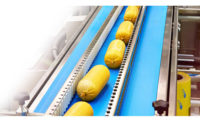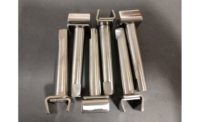The Challenge of Conveyors
In a protein processing facility, the basis for efficiency” the goal for any business” is quick, proper product flow and movement.
Facilities that overlook the importance of conveying systems and maintenance of those systems rarely garner the fruits of efficient production. Those managers and engineers who recognize the importance of conveyors, however, realize that motion begins and ends with those systems and their functionality.
According to a Business Wire report, the U.S. conveyor industry produced a 2009 revenue of $5.5 billion, serving a very wide variety of sectors with a plethora of options. Protein-processing plants, specifically, feature a varied spectrum of environments, with temperature, moisture and other handling extremes through much of the process.
Choosing the right system to match the application, therefore, is of the utmost importance on the front end of the process.
Craig Bertorello, vice president of operations at TriFactor LLC in Florida, offered five overall considerations processors should have when selecting a conveyor system in the September 2009 issue of The National Provisioner. Bertorello explained that the conveyor system should be adaptable to changing conditions, safe to operate, reliable and require minimal maintenance, be energy efficient, and cost-effective to operate.
Most important of those five, he said, was the cost-effectiveness of the system.
“[The] common view of ‘commoditizing’ conveyors is full of risk and exposure to the operation,” Bertorello added. “The wrong conveyor type ” or even a suitable type applied incorrectly or for the wrong reasons" can quickly undermine the warehouse or distribution center’s operating efficiency and long-term strategy, often dissolving profitability and/or stripping a company of its competitive advantages.”
Furthermore, experts in material handling implore companies to not short-change proper maintenance of their conveyors. Improper lubrication (or lack of a lubrication schedule) can quickly undermine the efficiency of the system, or even outright destroy the conveyor itself and create a hazardous situation for both workers and product.
Without proper inspection and maintenance of conveyors, their assorted parts, motors, belts, etc., managers may find themselves back at Square One, attempting to fit a new conveyor system into their facility.
Worse yet, a company could find itself funding a money drain, going through system after system, when simple, common-sense maintenance measures should be implemented to properly assess, repair or replace parts” rather than an entire line.
Adherence to these measures will keep your product moving efficiently and continuously, with only minimal downtime for assessments and repairs.
Facilities that overlook the importance of conveying systems and maintenance of those systems rarely garner the fruits of efficient production. Those managers and engineers who recognize the importance of conveyors, however, realize that motion begins and ends with those systems and their functionality.
According to a Business Wire report, the U.S. conveyor industry produced a 2009 revenue of $5.5 billion, serving a very wide variety of sectors with a plethora of options. Protein-processing plants, specifically, feature a varied spectrum of environments, with temperature, moisture and other handling extremes through much of the process.
Choosing the right system to match the application, therefore, is of the utmost importance on the front end of the process.
Craig Bertorello, vice president of operations at TriFactor LLC in Florida, offered five overall considerations processors should have when selecting a conveyor system in the September 2009 issue of The National Provisioner. Bertorello explained that the conveyor system should be adaptable to changing conditions, safe to operate, reliable and require minimal maintenance, be energy efficient, and cost-effective to operate.
Most important of those five, he said, was the cost-effectiveness of the system.
“[The] common view of ‘commoditizing’ conveyors is full of risk and exposure to the operation,” Bertorello added. “The wrong conveyor type ” or even a suitable type applied incorrectly or for the wrong reasons" can quickly undermine the warehouse or distribution center’s operating efficiency and long-term strategy, often dissolving profitability and/or stripping a company of its competitive advantages.”
Furthermore, experts in material handling implore companies to not short-change proper maintenance of their conveyors. Improper lubrication (or lack of a lubrication schedule) can quickly undermine the efficiency of the system, or even outright destroy the conveyor itself and create a hazardous situation for both workers and product.
Without proper inspection and maintenance of conveyors, their assorted parts, motors, belts, etc., managers may find themselves back at Square One, attempting to fit a new conveyor system into their facility.
Worse yet, a company could find itself funding a money drain, going through system after system, when simple, common-sense maintenance measures should be implemented to properly assess, repair or replace parts” rather than an entire line.
Adherence to these measures will keep your product moving efficiently and continuously, with only minimal downtime for assessments and repairs.
Looking for a reprint of this article?
From high-res PDFs to custom plaques, order your copy today!





